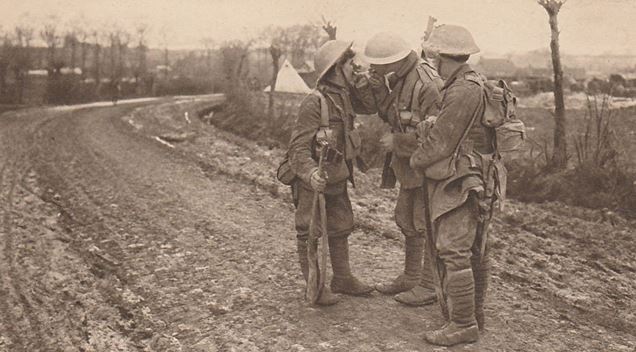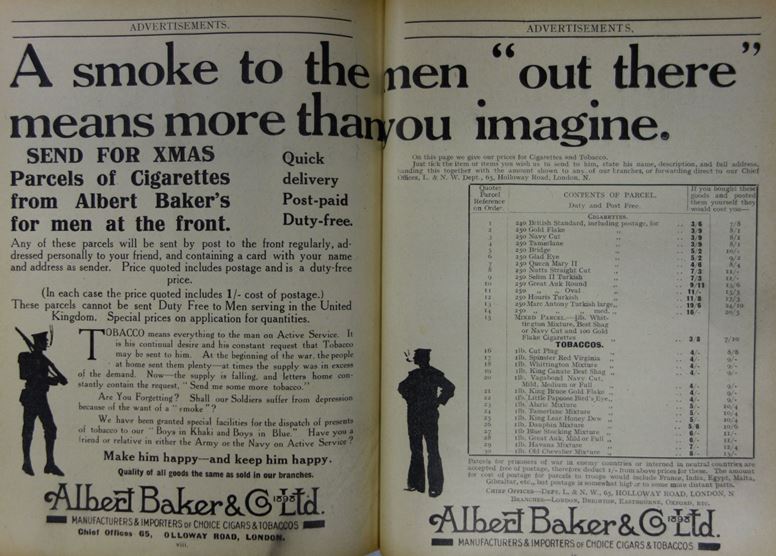Our First World War volunteer team have now been working for a year to add more information to our list of fallen railwaymen. This has involved in depth research into our wartime staff magazines, providing fascinating and sometimes surprising insights into Railway Company’s contribution to the war effort.
The months following the outbreak of war in August 1914 saw the establishment of numerous funds for good causes, both nationally and locally. Maintaining the tradition of paternalism often found in railway companies at the time, the London & North Western Railway lost no time in setting up a fund for wounded employees through the pages of its in-house magazine, the London and North Western Railway (L&NWR) Gazette.
Announced in the October 1914 issue, the object of the Tobacco Fund was to provide tobacco and cigarettes to every wounded L&NWR railwayman in hospital or nursing home in the UK. The Fund was administered from the General Manager’s Office at Euston Station.
Donations were invited, no matter how small. ‘A penny will purchase a packet of Woodbines’, declared the Gazette. By December 1914 there were already over 200 wounded L&NWR men to be supported as the Fund swung into action, having secured ‘an advantageous understanding…with some friends in the tobacco trade’.

It is hard to overstate the importance of a pipe of tobacco or a cigarette to vast numbers of servicemen during the First World War, whether to calm the nerves at times of stress, to stave off boredom, or simply to share with their comrades. Tobacco was no less important to them when the men returned wounded to England, as many letters published in the Gazette confirm, such as this one:
‘Wishing to thank you and all the members of the tobacco fund for their kindness in sending the cigarettes and tobacco, as it is one of a man’s comforts when he is in a sick bed, as the time drags so, and I have had such a long time of it.’
In March 1915 the Gazette announced that ‘300 parcels have been sent away to men distributed in hospitals from Aberdeen to Plymouth’. By December this had risen to over 1000. As the number of wounded increased so did the contents of the parcels dispatched across the country. Soon the tobacco and cigarettes were being supplemented by ‘other small comforts’ such as pipes, razors, shaving soap and brushes, notepaper, envelopes, pencils, tooth powder, chocolate, and walking sticks. The fund became known as The Tobacco and Comforts Fund from March 1916.

The gratitude of the men shines through in their letters to the Gazette. The ‘comforts’ were well-received, but perhaps the most appreciated item was the accompanying letter of good wishes sent to them all to remind them that they were not forgotten by their friends in the L&NWR:
…it is nice to know that there is still some one thinks of us doing our bit for good old England” (Sergeant R. F. Hurndall, Royal Fusiliers and Camden)
So for the many railwaymen who found themselves in hospitals far from friends and family, often unable to draw any pay for months on end, the parcels provided not only an invaluable source of practical help but also a vital element of moral support.
From modest beginnings the Fund built up steadily, receiving contributions from a variety of sources: individual donations (two shillings from R. Raffles of Southwaite), local collections (ten shillings from Telegraph Staff at Manchester London Road Station), help from local War Relief Funds (£5 from Crewe Permanent Way Department War Fund), and the proceeds of charity events (£40 from a Whist Drive and Social held in Lancaster). The generosity of L&NWR employees towards their colleagues is evident in the £1200 raised during the war (about £75,000 at present day values). The good work continued well into 1919 until the Fund finally closed in July.
The staff at Euston who administered the Fund faced many challenges in the course of the war: ever-growing numbers of L&NWR wounded (over 9,000 by the end of 1918), the ebb and flow of donations with periodic deficits, the competing demands of other charitable causes, and shortages of tobacco and other goods. In spite of this they succeeded in bringing comfort and consolation to several thousand of their wounded colleagues across the UK and in doing so their efforts are worthy of note.

You can find out more by viewing our staff magazine collection by visiting Search Engine.
Our list of fallen railwaymen is available online.
Hi Christopher,I have indeed thought about it. While it is true that grouping occluded quads could reduce the face count, in practice it does have some drawbacks, the most noticeable of which is that it could drastically increase the amount of overdraw. I’m not really sure if it would be a net benefit or cost, but my gut tells me that it would probably be the latter. If you ever try it, let me know what your results are! (I’d be happy to have my intuition proven wrong.)
http://tinyurl.com/gun-safe-review